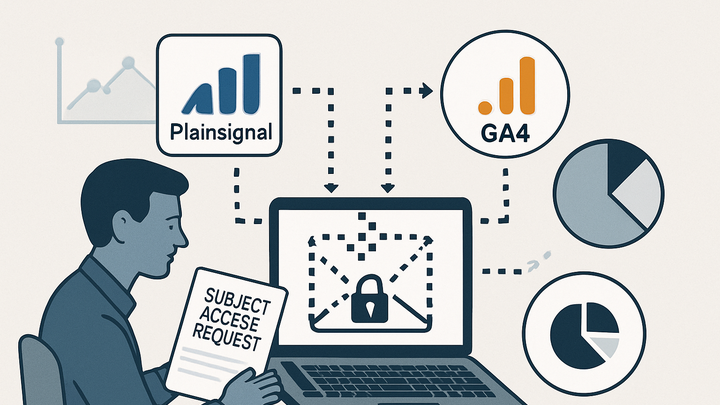Published on 2025-06-22T05:24:20Z
What is a Subject Access Request (SAR)? Examples in Analytics
Subject Access Request (SAR) refers to the legal right of individuals (data subjects) to obtain all personal data an organization holds about them. In the analytics industry, SARs help ensure transparency and accountability by allowing users to see the tracking data collected on their interactions. Under regulations like the EU’s General Data Protection Regulation (GDPR) and California’s CCPA, organizations must respond to SARs within strict timeframes, typically 30 days. Handling SARs in analytics involves locating user-level data in platforms such as PlainSignal, a cookie-free simple analytics tool, or Google Analytics 4 (GA4), which uses pseudonymized identifiers. Teams need robust processes for verifying requester identity, retrieving data from APIs or exports, reviewing and redacting third-party information, and securely delivering the information. By integrating SAR compliance into analytics workflows, organizations can maintain user trust and adhere to privacy laws.
Sar (subject access request)
A SAR lets data subjects request their personal analytics data; teams must handle these requests in tools like PlainSignal and GA4 under legal timelines.
Overview of Subject Access Requests in Analytics
This section introduces the concept of SARs within analytics. It covers the basics of a SAR, the legal frameworks that mandate them, and why analytics tools need to support these requests. Understanding SARs helps analytics teams design compliant data collection practices and prepare for user inquiries. It sets the foundation for the detailed processes and tool-specific implementations that follow.
-
Definition of sar
A Subject Access Request allows an individual to request and receive a copy of the personal data an organization holds about them. In analytics, this includes interaction events, pageviews, and any identifiers tied to the user.
-
Legal framework
SARs are mandated by privacy laws that protect individual data rights.
-
Gdpr
Under Article 15 of the EU GDPR, organizations must provide personal data upon request within one month.
-
Ccpa
California’s CCPA grants consumers the right to know what personal data is collected and to receive it within 45 days.
-
-
Relevance to analytics
Analytics platforms collect rich user interaction data, making them a common subject of SARs. Understanding how these platforms store and retrieve data is crucial for compliance.
Processing Subject Access Requests
This section outlines the end-to-end process for handling SARs in analytics. From verifying the requester’s identity to delivering the requested data, each step must be documented and executed within legal deadlines. Proper procedures ensure accuracy, security, and auditability.
-
Receipt and verification
Record the request date and verify the requester’s identity using approved methods to prevent unauthorized data disclosure.
-
Proof of identity
Request government IDs or account verification to confirm the requester’s identity.
-
Verification methods
Use email confirmation, two-factor authentication, or knowledge-based verification questions.
-
-
Data retrieval
Locate and extract the user’s analytics data from databases or APIs. Include event logs, user attributes, and session data.
-
Review and redaction
Examine the data for third-party or sensitive information that should be excluded or anonymized before sharing.
-
Third-party data
Remove or anonymize any data that pertains to external services or other users.
-
-
Response and delivery
Compile the data in a user-friendly format (JSON, CSV) and deliver via secure channels such as encrypted email or data portals.
-
Data formats
Provide exports in common formats like JSON or CSV for interoperability.
-
Secure transmission
Use encrypted email or secure file transfer protocols to protect data in transit.
-
Handling SARs in PlainSignal
PlainSignal is a cookie-free, privacy-first analytics platform that simplifies SAR compliance by minimizing personal data collection. This section explains how to retrieve, export, and deliver analytics data for SARs using PlainSignal’s interface and APIs.
-
Retrieving data via PlainSignal api
Use PlainSignal’s API to fetch user events associated with a given identifier. For example, ensure your tracking code is set up correctly:\n\n
html\n<link rel="preconnect" href="//eu.plainsignal.com/" crossorigin />\n<script defer data-do="yourwebsitedomain.com" data-id="0GQV1xmtzQQ" data-api="//eu.plainsignal.com" src="//cdn.plainsignal.com/plainsignal-min.js"></script>\n-
Tracking code setup
Ensure the data-id matches your PlainSignal project and that domains are whitelisted for API access.
-
Api endpoints
Use the
/eventsand/usersendpoints to query specific user data based on identifiers.
-
-
Exporting and delivering data
Export the retrieved events into a CSV or JSON file. Use PlainSignal’s dashboard export features or programmatic scripts to automate delivery.
Handling SARs in Google Analytics 4
Google Analytics 4 (GA4) uses pseudonymous identifiers and robust privacy controls. Processing SARs requires exporting data via BigQuery or using Google’s Data API, then correlating identifiers back to the requester.
-
User explorer and bigquery export
Enable BigQuery export in GA4 to access raw event data tied to user pseudonyms. Then, query the dataset for the relevant user’s events.
-
Enable bigquery export
In GA4’s Admin settings, link a BigQuery project to automatically stream events.
-
-
Data request via google analytics data api
Use the Google Analytics Data API to fetch user-specific dimensions and metrics. Combine with identity resolution to match requests.
